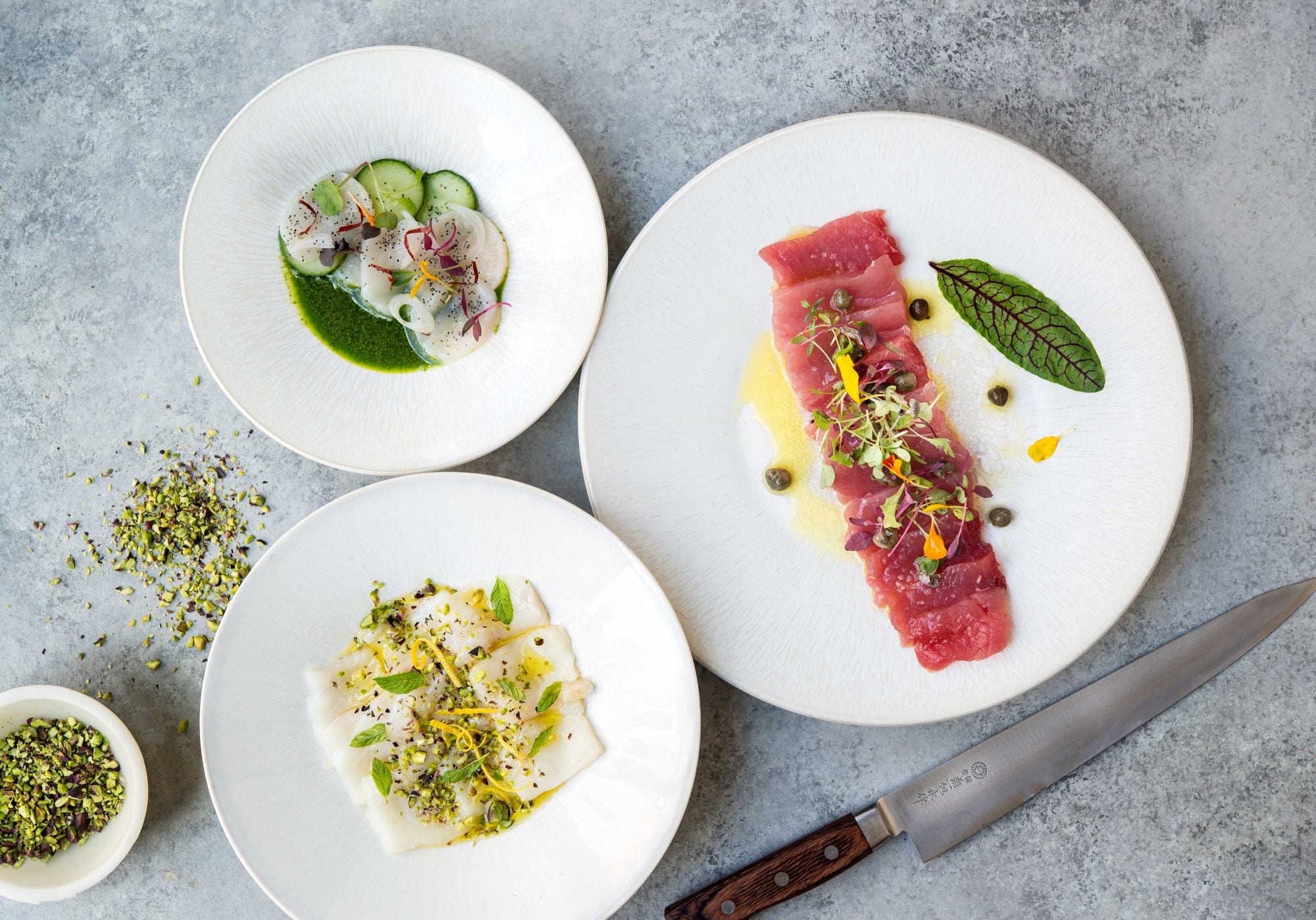Italy’s Answer to Sashimi

You don’t need advanced knife skills or a lot of ingredients to make crudo at home—just a bit of fresh fish and good olive oil.
Japan has sashimi, Hawaii has poke, and Peru has ceviche, but in Italy (and Sicily in particular) it’s all about pesce crudo.
I became well acquainted with pesce crudo (Italian for “raw fish,” unsurprisingly) during a recent trip to Sicily. I did my best to sample it all over the island in the name of “culinary research”—sweet and succulent red shrimp, briny and buttery sea urchin, pleasantly chewy abalone, umami-packed anchovies, and baby squid.
What became quickly apparent is that crudo is not about detailed techniques or impressive knife skills, but rather about appreciating seafood at its peak freshness. Crudo at its simplest is nothing more than raw seafood dressed with olive oil, sea salt, acid (such as lemon juice or good quality vinegar), and sometimes pepper.
Pesce crudo is light and delicate, making it a great way to start a meal. It’s also easy and quick to prepare at home. The key part is tracking down quality fish—sometimes referred to as sushi grade. Your best bet is to buy fish from a fishmonger whom you’ve done business with (better still, make friends with a fisherman). With advanced refrigeration and science on the customer’s side, finding quality fish is as easy as driving down to your local Whole Foods, or fish shop.
Once you’ve procured your seafood, there are a few pointers to keep in mind. First, be sure to use a very sharp knife when portioning, and always cut the fish against the grain. Keep the seafood refrigerated while prepping the other ingredients to ensure freshness (you can even pop your fish into the freezer for 10 minutes or so to make it easier to slice). Finally, it’s always a good idea to wait to add the lemon juice until just before serving, since too much acid too early will turn your fish into ceviche.
Since there’s no cooking involved, the quality of the complementary ingredients, particularly the oil, can really make a difference as well. Depending on the type of fish, this could be a full-bodied, fruity, herbaceous Sicilian extra-virgin olive oil or perhaps an extracted nut oil, such as pistachio oil or hazelnut oil. With a stronger-tasting fish (like Hamachi or salmon), you could use an extra-virgin olive oil with a more assertive, bolder flavor profile. With a milder-tasting fish (like white fish or scallops), consider a more subtle, nuanced oil so as not to overpower its delicate flavor. That being said, it’s all about personal preference, so don’t be afraid to experiment a bit.
Ingredients
- 8 ounces sushi-grade ahi tuna
- Squeeze of lemon
- Extra-virgin olive oil
- 2 teaspoons capers, rinsed
- Microgreens (such as basil) for garnish
- Pinch of flaky sea salt
Given the freshness and buttery texture of the sushi-grade tuna I found at my local farmers’ market, it needed nothing more than a squeeze of lemon and a drizzle of good-quality extra-virgin olive oil. The capers and microgreens, while not essential, lend salinity and a pop of green.
- Place the fish in the freezer for 10 minutes. Squeeze a little lemon juice on the serving plate. Remove the tuna from the freezer. Slice the tuna thinly with a sharp knife and lay the slices on the plate, overlapping slightly.
- Drizzle the tuna with olive oil. Sprinkle capers on top. Garnish with microgreens. Season with sea salt.
Ingredients
- 8 ounces sushi-grade white fish (such as snapper, bream, bass, grouper, rockfish, yellowtail)
- Juice of 1 lemon
- Extra-virgin olive oil
- Chopped pistachios for garnish
- Leaves from few sprigs of mint
- Zest of 1 lemon
- Pinch of flaky sea salt
You can use several kinds of whitefish in this recipe—such as snapper, bream, bass, grouper, rockfish, or yellowtail. Of course, make sure it’s super fresh. The combination of pistachios, lemon, and mint is a classic pairing that I encountered throughout Sicily.
- Place the fish in the freezer for 10 minutes. Slice the fish thinly with a sharp knife and lay the slices on the plate, overlapping slightly.
- Drizzle with lemon juice and olive oil. Garnish with pistachios, mint leaves, and lemon zest. Season with sea salt.
Ingredients
- Crudo
- 6 scallops
- Basil oil
- 1 cucumber
- Squeeze of lemon
- 1 small shallot, thinly sliced
- Microgreens (such as arugula, radish)
- Pinch of flaky sea salt
- Basil Oil
- 1 cup packed basil leaves
- ½ cups extra-virgin olive oil
- Pinch of flaky sea salt
When raw, scallops possess a mild and sweet flavor. In this recipe, I added a layer of summery flavor with a basil-infused olive oil.
Basil Oil
- Bring a pot of water to a boil. Prepare an ice water bath. Drop the basil leaves in the boiling water for 1 minute. With a slotted spoon, remove the leaves and place in the ice bath to cool down. Drain. Squeeze out water and dry with paper towels.
- Place the blanched basil, oil, and salt into a blender and puree until very smooth. Strain through a fine mesh sieve.
Crudo
- Place the scallops in the freezer for 10 minutes.
- Drizzle some basil oil on the bottom of a shallow serving bowl. Slice the cucumber into thin rounds and place in the bowl.
- Remove the scallop from the freezer. Slice the scallops thinly, in thirds horizontally, with a sharp knife and lay the slices on the plate, overlapping slightly with the cucumber. Squeeze a little lemon juice on top.
- Garnish with shallots and microgreens. Season with sea salt.



